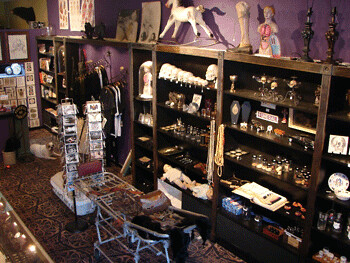
I used to work as a receptionist at a chiropracter’s office. I was in it for the swag: spine keychains (used for assembling an elaborate multi-tiered choker necklace), spine lamps (OK, ours weren’t as cool as the Mark Beam version), and one incredible metallic spine chair that looked like it belonged at a Giger bar… which I coveted, but never got to own. Discovering Bjorn Johansson’s lovely spine-inspired letters on the beautiful I Love Typography blog this morning took me back to those glory days.
It’s not a full font, just the designer’s experiment for creating type. Like my Becher font experiment, only a few letters exist. It wonderful to one day see them all. It would look nice paired with Value Pack, don’t you think?

Posted by Nadya Lev on August 4th, 2008
Filed under Art, Design, Goth, Medical | Comments (8)

Too many good things going on in this picture not to post! A tea-colored composition of all my favorite fashion things: ruffs, rosettes, oriental-style hair, intricate sleeves and medical crosses, drawn by Christine. Hot! I must say that I’m not crazy about the striped stockings here. Maybe if they were transluscent and had that same tea color as the rest of the outfit, it would work better. As of now, they look like they were bought on Ebay, if that’s possible to tell from a drawing. Overall I find this picture delicious to look at, even though it might not be Christiane’s best work from a technical standpoint.
I would love to see the same fashion concepts executed as straight-up linework with a more fluid composition, along the lines of this amputastic masterpiece that Christiane completed in 2005:

Posted by Nadya Lev on April 10th, 2008
Filed under Art, Fashion, Fetish, Medical, Ye Olde | Comments (5)
Prosthetics are hot! That’s how I’ll console myself if I ever lose my hand in a terrible accident. I picture a long-fingered, razor-nailed chrome hand for everyday wear; a sleek jeweled hand with fingertips that project light (or film!) for the evenings; and for special occasions, I want a sock puppet that’s also a flamethrower. In my toolkit, I would also like to have something Ye Olde. Ideally I’d love to get my remaining hand on the following, eloquently written up for us by guest blogger David Forbes (aka Coilhouse commenter ampersandpilcrow). – Nadya
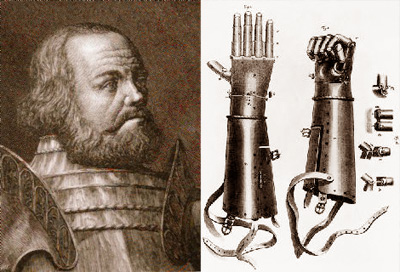
Götz Von Berlichingen had a problem. It was 1504 and, at the tender young age of 24, the plundering knight, mercenary and all around bastard had the upper part of his right arm torn off in a cannon blast. As someone who made his living off war and already had a sizable enemies’ list, Götz needed his killin’ hand.
So he got another one. Made of iron.

However, this was no crudely shaped hunk of metal — it was a mechanical masterpiece, centuries ahead of its time. The iron hand not only allowed Götz to return to battle, but later helped lay the foundation for modern prosthetics. Complete with articulated fingers, spring action and an array of levers and buttons, the hand allowed a degree of control that’s stunning even today. Fitted with it, Götz could do the following:
Posted by David Forbes on March 12th, 2008
Filed under Medical, Museum, Personal Style, Uber, War | Comments (35)
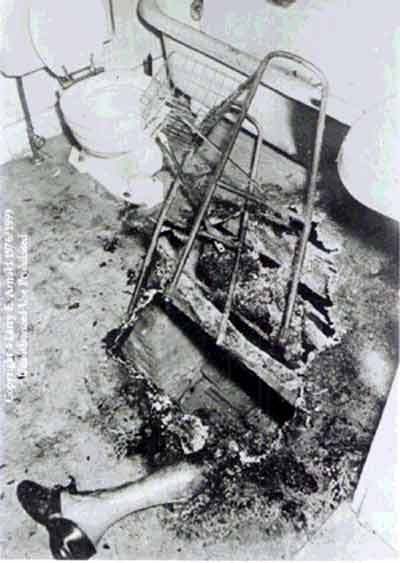
a befuddling coroner’s photo of retired doctor John Bentley, 1966
Dear diary, today my heart leapt when Agent Scully suggested spontaneous human combustion…
-Agent Fox Mulder
Ho hum, the good old days. Pluto was still a planet, Nessie, Big Foot and leprechauns frolicked unfettered among us and the theoretical possibility of true Spontaneous Human Combustion seemed feasible. Well, to me, at any rate. I’m not really sure what’s to blame for that. (Repo Man? Krook from Bleak House? My unhealthy childhood obsession with Brad Dourif?) In any case, Ablaze! was required bathroom reading in my apartment for many years. Until quite recently, I clung to my hope that there was a chance, albeit remote, of my asshole ex being inexplicably reduced to a pile of ashes with feet.
Alas, thanks to a series of informative scientific articles and National Geographic specials, believers must face facts: SHC is a most likely myth.
Posted by Meredith Yayanos on January 3rd, 2008
Filed under Books, Cryptohistory, Medical, Misinformation, Science, Testing your faith | Comments (13)
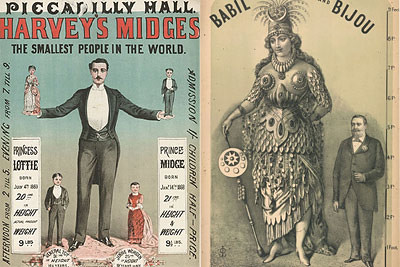
The British Library has put up a great informational page and gallery of Victorian Freak Show Posters.
“Novelty acts relied a great deal on shock, therefore performers were not revealed in the flesh to audiences until money had changed hands. Titillating publicity was crucial, as the people described in these adverts often bore little resemblance to what lay behind the curtain or turnstile. Exaggerated and stylised illustrations lent age to dwarf acts, stature to giants, and plausibility to mermaids and bear boys. The advertisers of these shows aroused the curiosity of the audience by overplaying, often entirely inventing, ‘true life’ stories.”
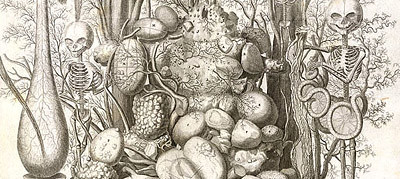
This online exhibit is part of a collection called Bodies of Knowledge, which also includes medieval astrology, Chinese acupuncture (with amazingly detailed diagrams), Renaissance anatomy lessons, Ruysch’s “fantastical cabaret of preserved body parts,” the first X-Rays ever taken, and lots of other morbid and fascinating eye candy. Thanks for ze tip, Jerem!
Posted by Nadya Lev on November 16th, 2007
Filed under Art, Goth, Medical, Ye Olde | Comments (6)
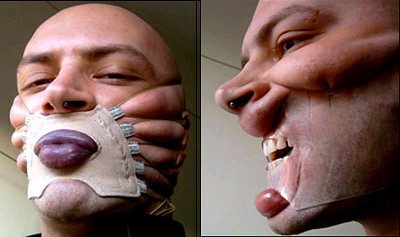
We previously blogged about Paddy Hartley’s Project Facade, cialis a uniform-sculpture exploration of wartime trauma and facial reconstruction. But before Hartley became known for Project Facade, ambulance he received international acclaim for another project – a series of face corsets focused on exploring attitudes towards plastic surgery and ideals of facial beauty.
The bioglass and cinching invoke Botox, collagen, implants and other techniques that stretch and compress our faces into their ideal shape – but only temporarily. Hartley elaborates on these ideas and more in an excellent interview over at We Make Money not Art.
Any man who puts pictures like this of himself on the internet in order to make an artistic point has our respect forever.
More face corsets after the jump!
Posted by Nadya Lev on October 23rd, 2007
Filed under Art, Fashion, Medical | Comments (7)
A long-time Angel City resident, i have the fortune and pleasure of living very close to this delightful shop [Now two shops, to be exact, as Necromance has expanded] and have been frequenting it since i was a wee lunchbox-toting spookling.
Owned by an exceptional and fashionable lady named Nancy, Necromance first opened its doors in New Orleans long ago and LA is very lucky to have it here today. The window displays are always brimming with eye candy – antique writing cabinets adorned with bones and dried flowers, candles beside aged porcelain dolls and taxidermied deer. You’ll be lured in by the faint trickle of 1920’s music, vintage glass, charts of mysterious anatomical regions and dim glare of strange medical devices alongside exotic beetles. Inside the shops’ incensed walls you’ll find a menagerie of…amazing stuff. It’s impossible to list all they offer here, but their online store will give you something of an overview.
It isn’t all collectibles and home decor, either. Victorian mourning jewelry, postcards, books and, yes, black toilet paper are some of the practical items Necromance offers. If you ever find yourself in Los Angeles i advise you march right over to Melrose Avenue and pay tribute to this gem. Until such time you can peruse and purchase online at Necromance.com

*images courtesy of Necromance.com
Posted by Zoetica Ebb on October 10th, 2007
Filed under Adornment, Medical, Shopping, Ye Olde | Comments (10)
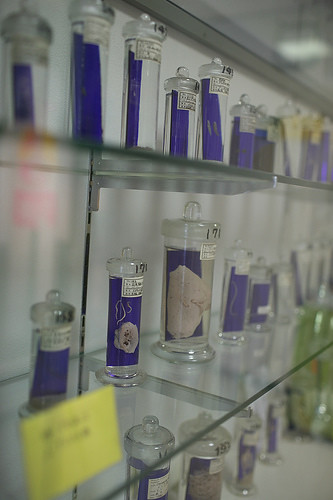
Meguro Parasitological Museum, originally uploaded by Coilhouse.
Boasting 45,000 parasite specimens immersed in formaline, the museum is a privately-founded and now government-aided establishment. With its parasite-positive atmosphere the museum lives up to its slogan and is a popular date spot. It’s easy to see why! Milky white samples float peacefully on night sky-blue backdrops in neat, glass jar rows. Friendly interactive displays show diagrams of various relationships between animals and parasites which inhabit them. A long ribbon hangs near a case displaying an impressive tapeworm, nearby sign encouraging the visitor to play with the ribbon to understand the tapeworm’s length. Don’t fear – this is an educational adventure, friends!
The museum isn’t particularly large, and won’t take more than an hour to conquer. Admission is free and photography is allowed. I highly recommend you pay our little friends a visit, even if you’re only in Tokyo for a few days. You’ll be glad you tore yourself away from the hostess bars, gluttony and experimental toilets in favor of learning!
Posted by Zoetica Ebb on October 2nd, 2007
Filed under Japan, Medical, Museum | Comments (3)
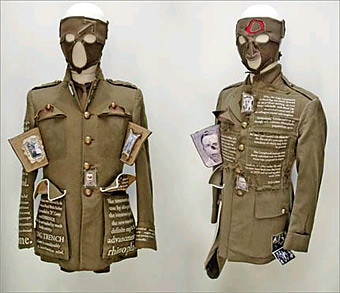
Paddy Hartley Project Facade, originally uploaded by Coilhouse.
Project Facade tells “the personal and surgical stories” of servicemen who sustained deforming injuries during World War One. The site displays the uniform sculptures as components of thoroughly-researched case studies that include the name, face and injury catalogue of each soldier, presenting a sculpture that’s unique for each man’s story. The most detailed case studies belong to Sea. AJ, Fai. W, and Top. V, though all are worth examining. Warning: there are images of facial deformities here that are not for the weak of heart!
Some uniforms are fragmented with blood-red stitching reminiscent of shrapnel wounds, others are inscribed with writing that conjures medical records or letters from loved ones, and many uniforms are complemented by stiff masks that project power and authority while hiding a the personal horror of a face literally erased by war. The project is two-fold: in addition to examining the history of facial/body reconstruction with the aforementioned uniform sculptures, Hartley also investigates modern techniques by creating Bioactive Glass Facial Implant sculptures, comparing today’s technology to the surgical techniques that Sir Harold Gillies pioneered in the early 1900s. The result is a powerful artistic response to the history of facial reconstruction, as experienced both by the patient and as the surgeon.
Posted by Nadya Lev on August 20th, 2007
Filed under Art, Medical, Uniform, War | Comments (2)













